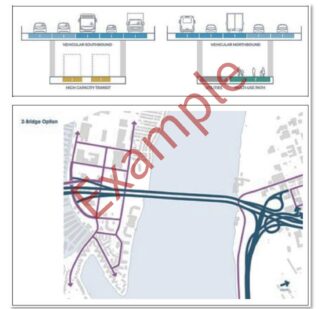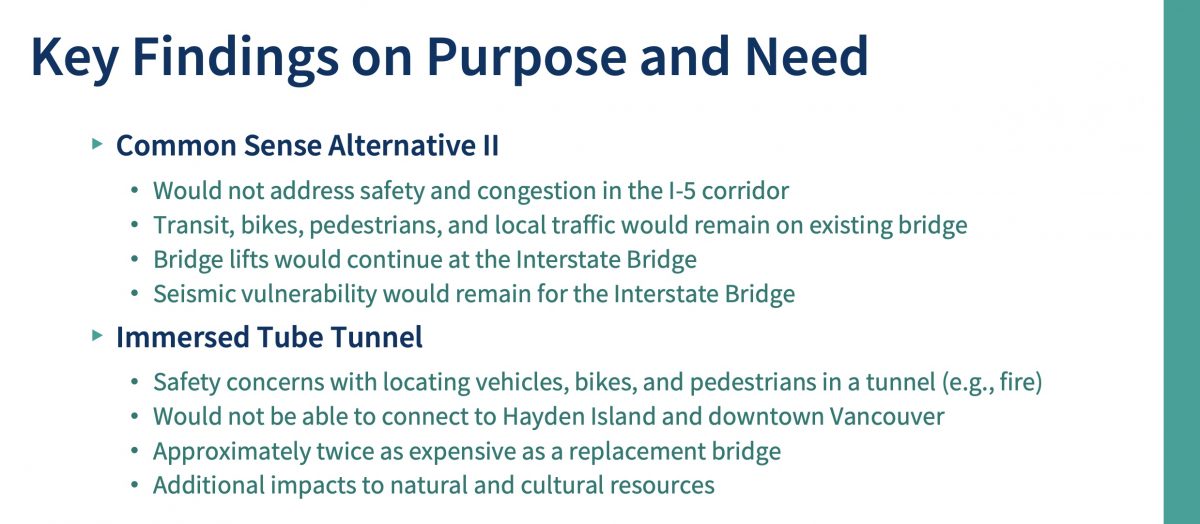
“High speed rail as a transit component to the Interstate Bridge was dismissed during the screening process because it neither increased vehicular capacity nor decreased vehicular demand…”
— IBR Program memo
The second attempt to replace and expand I-5 between Washington and Oregon is steaming ahead, on track to have a full project designed by early 2022. The Executive Steering Group for the “Interstate Bridge Replacement program”, catching up from a month off, met Wednesday night and spent time discussing what the project will not be.
In conjunction with a memo produced by the project team, the group went through a list of options that had been given “one last look”, as Metro President Lynn Peterson characterized it, but were officially being discarded. On the list was an immersed tube tunnel, the “Common Sense Alternative II”, and the idea of including high speed rail on the new bridge.
High speed rail between Vancouver, B.C. and Portland is currently being studied by the State of Washington, and integration with this project could be a significant step forward, but the project team has ruled it out. “In the future, high speed rail has the potential to be a climate friendly way to connect the major cities on the West Coast to each other,” the memo states. “However, high speed rail as a transit component to the Interstate Bridge was dismissed during the screening process because it neither increased vehicular capacity nor decreased vehicular demand, and it did not improve transit performance in the I-5 bridge corridor.”
It’s not surprising to see these options discarded, though, since the official purpose and need for the IBR program is exactly the same as the failed Columbia River Crossing, without the addition of climate change impacts and equity considerations that were explicitly rejected earlier this year.
Advertisement


Moving forward, Program Administrator Greg Johnson made clear that four questions are taking center stage right now: how many lanes the highway will have, will the bridge carry light rail or bus rapid transit, will there be a direct interchange on Hayden Island, and will the North Portland Harbor Bridge be retrofitted (as proposed in the CRC) or fully replaced. This winter, alternatives will be presented for all of those questions. The current plan is to present a full project to the joint committee of the state legislatures by March, meaning this winter could be the most critical time to pay attention to the project.
Without a fundamentally different approach all signs are indicating we’ll arrive right back at the Columbia River Crossing’s design.
So far, the group hasn’t looked at any design options in detail, but they were shown a slide that included an “example bridge alignment” (above) that looks almost identical to the preferred alternative from the Columbia River Crossing, with ten marked lanes on top of two bridges.
Several ESG members noted the absence of a road pricing structure among the four primary questions. But that issue could, and almost certainly should, influence the project’s design. A 2013 report showed a tolled I-5 crossing would produce traffic levels in 2036 lower than even 2012 levels. Tolling I-205, which models suggest would see a massive increase in traffic with a tolled I-5, might change the dynamics. If the goal is to severely reduce climate impacts, as several ESG members have stated at past meetings, then a design that reduces traffic volumes should be at the center.
Commissioner Jo Ann Hardesty wasn’t present for most of the meeting, with PBOT Director Chris Warner filling in for her. Hardesty has been more adamant about a comprehensive pricing strategy than anyone else on the Executive Steering Group and her voice was missing from the discussion. But Lynn Peterson told the group she wanted it to be “very clear” on behalf of Metro Council that “from our perspective we don’t see congestion pricing as a financial, final step…it is an input into transportation demand management and GHG emission reduction.”
But Greg Johnson described the issue of tolling as being on a second tier below the issue of what the bridge looks like. He also described “more equity, more climate” as being on that second tier. But he did say that the project is coordinating with ODOT’s work on studying congestion pricing further south on I-5 and I-205. Peterson suggested additional work needs to happen: “I think this needs to be hand in glove, not two separate things…[it] can’t be two separate projects where we trust that ODOT is going to do one thing later,” she said.
How congestion pricing influences the design of the project will be more clear by November and December, but without a fundamentally different approach all signs are indicating we’ll arrive right back at the Columbia River Crossing’s design.
— Ryan Packer, @typewriteralley on Twitter
— Get our headlines delivered to your inbox.
— Support this independent community media outlet with a one-time contribution or monthly subscription.

